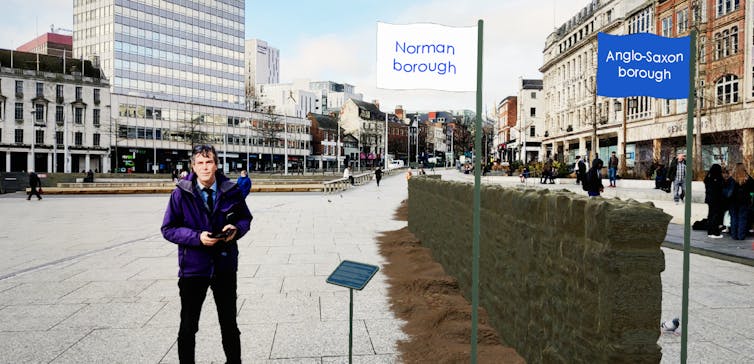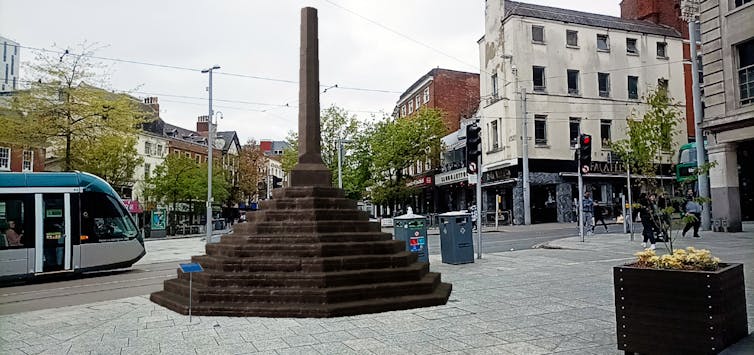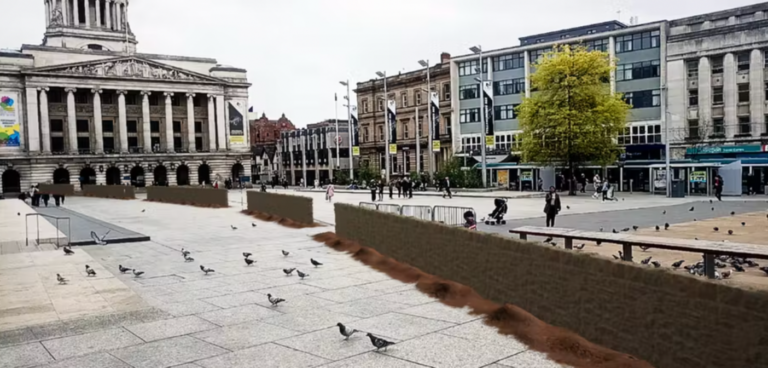Fascinated by Nottingham city’s lesser-known history, last year a lecturer at Nottingham Trent University decided to make the hidden secrets of Nottingham, and its intangible heritage as the “city of the towns”, better known by using augmented reality (AR) technology.
Using historical maps and archaeological data, Andrea Moneta led a research team at Nottingham Trent University to recreate in 3D the original shape and position of the Market Wall that separated the Norman borough from the Anglo-Saxon borough in Nottingham.
A divided Market Square
The large market square, which is still there and is the second largest market square in the UK, was shared by the two boroughs but was divided by a wall around 1.6m (5.2ft) high. The wall was to separate livestock from other goods and to define different administration and laws. People were, however, allowed to move freely from one side to the other, as is clearly shown in historical maps of Nottingham and archival documentation.
The purpose of the Nottingham Market Wall was as an administrative boundary between the two boroughs and was very different from many other segregation walls, like the Berlin Wall. In medieval Nottingham, both sides could “cross the border” any time they wanted, living together in peace, sharing their culture, and creating a “melting pot” that is probably the secret behind the character of this unique town.

Moneta’s interest in the wall started when she noticed in the old Market Square a long water drain with a grill that had a strange shape. She later discovered that it was inspired by an old map of Nottingham depicting the Market Wall. She immediately thought that this important yet unknown aspect of Nottingham’s heritage should be visually revealed. The best way, she believed, was by using augmented reality technology, not just for the possibility to have a realistic view of the historical wall blended right into the user’s view of the real world, but also because AR is a technology available on our smartphones so that anyone can easily discover and interact with the deep roots of the city.
Creating the Market Wall AR app
The project aimed to invite Nottingham’s citizens and tourists to experience and interact with the historical roots of the city through virtual archaeology, using their smartphones or tablets. After downloading and installing the free AR app from www.themarketwall.com, users can go into the Old Market square and visualise through their smartphone where the Market Wall was and interact with it, getting closer and around, walking along its length.
The app also includes two other historical elements, the Malt Cross, a pillar on a pile of ten steps where public announcements and punishments (whipping) were made that were located at the crossing between Long Row and Market Street. The other element is the ducking stool, a tool to punish mainly women for scolding or backbiting (talking behind someone’s back) by bonding them to a chair fixed on a pole so that they could be immersed in a pond that was originally located where the fountain in the Old Market square now is.
These landmarks of public announcements and punishments can help users immerse themselves in medieval Nottingham, experiencing the role of the historical Saturday Market, the old name of the square, in the social and political life of Nottingham, beyond trade and commerce.

Using the AR app in the Old Market square, visitors can see how the Market Wall, Malt Cross and ducking stool once looked and virtually interact with them. AR technology can contribute in an easy, enjoyable way to reveal the identity of places and the intangible attributes of heritage that are not physically visible anymore.
The app created interest in the local and national press, but it also generated curiosity in the citizens. Over 100 users to date have downloaded the app.
With smartphones becoming more powerful, AR technology is developing and creating more possibilities to integrate virtual reality with our real world. Digitally enhancing natural environments, the built environment and heritage sites, AR on smartphones and tablets are extending museums and exhibition beyond their traditional parameters and possibly also audiences.
Connecting reality with the “metaverse”, a collective virtual open space that is believed to be the next evolution of the internet, could make each city a museum that is ready to be experienced across the past, present and future.![]()
This article is authored by Andrea Moneta, senior lecturer in theatre design at Nottingham Trent University. It is republished from The Conversation under a Creative Commons license. Read the original article.








